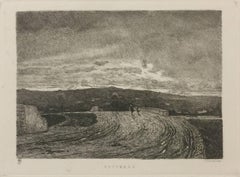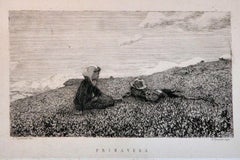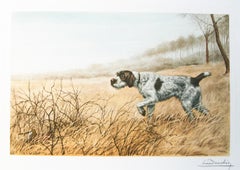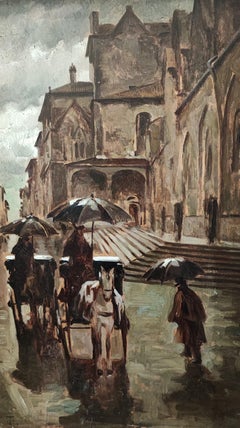Telemaco Signorini Art
to
2
Overall Width
to
Overall Height
to
2
2
2
1
1
1
1
1
1
1
2
2
10,138
2,779
1,375
1,366
2
Artist: Telemaco Signorini
Novembre
By Telemaco Signorini
Located in Roma, IT
Signed the plate with the artist's monogram “TS”lower left. Inscription “C. Lovera imp” lower right. Very rare print from “L'Art in Italia”, 1871.Original Prints.
Image Dimensions : ...
Category
1870s Realist Telemaco Signorini Art
Materials
Etching
Spring - Original Etching by Telemaco Signorini - 1873
By Telemaco Signorini
Located in Roma, IT
Landscape and figures. Signed on plate.
Image Dimensions : 15x21 cm.
Publisher : Editore Lovera
Excellent conditions
This artwork is shipped from Italy. Under existing legislation, ...
Category
1870s Realist Telemaco Signorini Art
Materials
Etching
Related Items
Doorway of the Doges, Venice
By Donald Shaw MacLaughlan
Located in New York, NY
Donald Shaw MacLaughlin (1876-1938), Doorway of the Doges, Venice, etching with plate tone, 1909, signed bottom right [also signed and dated in the plate]. Reference: Marie Bruette 1...
Category
Early 1900s Realist Telemaco Signorini Art
Materials
Etching
Griffon With Woodcock original signed etching by Leon Danchin
By Leon Danchin
Located in Paonia, CO
Griffon With Woodcock is an original etching by Leon Danchin showing a Griffon in a field pointing at a Woodcock trying to hide in the brush. This color etching is in good conditi...
Category
20th Century Realist Telemaco Signorini Art
Materials
Etching
$950
H 20.5 in W 31.5 in
"Arch Of Septimius, Rome" Large etching and aquatint.
By Luigi Kasimir
Located in San Francisco, CA
This artwork titled "Arch of Septimius, Rome" 1923, is a color etching and aquatint on wove paper by noted Austrian artist Luigi Kasimir, 1881-1962. It is hand signed in pencil by t...
Category
Early 20th Century Realist Telemaco Signorini Art
Materials
Etching, Aquatint
$1,600
H 40 in W 30.25 in D 1.5 in
L’Hiver a Paris ou La Neige a Paris
By Félix Hilaire Buhot
Located in New York, NY
Felix Buhot (1847-1898), L’Hiver a Paris ou La Neige a Paris, 1879, etching, aquatint, drypoint, roulette. [signed and dated in the plate Felix Buhot Par...
Category
1870s Realist Telemaco Signorini Art
Materials
Drypoint, Etching, Aquatint
Golden Gate, San Francisco, California
By Luigi Kasimir
Located in San Francisco, CA
This artwork titled "Golden Gate, San Francisco, California" c.1930 is a color etching on watermarked Kasimir Vienna paper by Austrian artist Luigi Kasimir, 1881-1962. It is hand sig...
Category
Early 20th Century Realist Telemaco Signorini Art
Materials
Etching
A Douelan
By Adolphe Beaufrère
Located in New York, NY
Adolphe-Marie Beaufrère (1876-1960)
A Douelan, etching, 1923, signed in pencil and numbered (21/50) [also initials and date in the plate]. Reference: Morane 23-07, BN Laran 175. Seco...
Category
1920s Realist Telemaco Signorini Art
Materials
Etching
Klosterneuburg, Austria
By Luigi Kasimir
Located in San Francisco, CA
This artwork titled "Klosterneuburg, Austria" c.1950 is a color etching by Austrian artist Luigi Kasimir 1881-1962. It is hand signed by the artist's estate in pencil at the lower center. The plate mark (image) size is 7.75 x 5.85 inches, framed is 18.15 x 15.15 inches. It is framed in a wooden antique silver frame. It is in very good condition.
About the artist.
Luigi Kasimir was born in 1881 at Pettau, today Ptuj, Slovenia, then a part of the Austro-Hungarian monarchy. He inherited his talent from his ancestors; his grandfather was a painter and a poet, and his father an officer in the Habsburg army, who later became a professional painter. Kasimir attended the Vienna Academy of Art where he studied under Wilhelm Unger, who introduced him to the technique of the coloured etching, and also to his future wife, the artist Tanna Hoernes.[1] He died in 1962 in Grinzing, a suburb of Vienna.Kasimir was among the first to develop the technique of the coloured etching. Before this, prints were usually hand-coloured with the colour being applied in a casual, haphazard manner. Kasimir would first create a sketch usually in pastel, he then transferred the design on as many as four to six plates, printing one after the other and applying the colour on the plate, all done by hand.
Kasimir is mainly famous for his etchings, but he also produced some oil painting, as well as some pastels. One of his favourite genres was the landscape, or veduta. He demonstrated a predisposition street scenes, and tourist landmarks. He depicted places from all over Europe, mainly Italy, Austria, and Germany. He also travelled to the United States to do a series of etchings of famous sights ranging from urban landmarks such as New York City skyscrapers, to natural wonders like Yosemite Valley. Luigi Kasimir’s etchings...
Category
Early 20th Century Realist Telemaco Signorini Art
Materials
Etching
Limehouse
By James Abbott McNeill Whistler
Located in New York, NY
James McNeill Whistler (1834-1903), Limehouse, etching, 1859. References: Glasgow 48, fifth state (of 6), Kennedy 40, third state (of 3), signed with the butterfly in pencil in the lower margin. [Also signed and dated in the plate.]With margins, 5 x 7 7/8 inches, the sheet 6 1/2 x 9 1/2 inches. Published as no. 12 in A Series of Sixteen Etchings of Scenes on the Thames and Other Subjects, otherwise known as the Thames Set. In good condition apart from a soft diagonal fold in the sky.
A very fine impression, in black ink on a thin Japan paper.
Provenance: Dr. John W. Randall (cf. Lugt 2130), without his mark, annotated on the mat.
Limehouse, the entrance to the West Indies Docks, lies opposite the Surrey Commercial Docks in Rotherhithe, along the lower Thames.
It’s unusual to find the signed butterfly (or any pencil signature) on the early London etchings, but it is known that Whistler signed...
Category
1850s Realist Telemaco Signorini Art
Materials
Etching
Printemps Breton
By Jean-Emile Laboureur
Located in New York, NY
Jean-Emile Laboureur (1877-1943), Printemps Breton, 1926, drypoint, roulette, aquatint, etching; signed in pencil lower left and numbered lower right (37/50) with the imp inscription...
Category
1920s Realist Telemaco Signorini Art
Materials
Engraving, Drypoint, Etching, Aquatint
A J Meyer Etching Dulwich College London c. 1920 British School print
Located in London, GB
To see our other views of Public Schools, Oxford and Cambridge, scroll down to "More from this Seller" and below it click on "See all from this Seller" - or send us a message if you cannot find the view you want.
A J Meyer (British, fl 1900-1930)
Dulwich College
Etching
22x30cm
Sadly little is known of Meyer, an accomplished artist and particularly producer of etchings. He was one of many artists to join the craze for etchings started by Whistler and that died out after the 1929 Wall Street...
Category
1910s Realist Telemaco Signorini Art
Materials
Etching
$308
H 8.67 in W 11.82 in
Pacific Ocean Currents, Handmade Cyanotype Seascape in Blue, Waves Landscape
By Kind of Cyan
Located in Barcelona, ES
This is an exclusive handprinted limited edition cyanotype.
"Pacific Ocean Currents" is a handmade cyanotype print of rough water texture resembling Pacific Ocean swell.
Details:
+ ...
Category
2010s Realist Telemaco Signorini Art
Materials
Paper, Emulsion, Engraving, Etching
Heiligenblut, Austria
By Luigi Kasimir
Located in San Francisco, CA
This artwork titled "Heiligenblut, Austria" c.1950 is a color etching by Austrian artist Luigi Kasimir 1881-1962. It is hand signed by the artiste's estate in pencil at the lower center. The plate mark (image) size is 7.75 x 5.75 inches, framed is 17.85 x 15.15 inches. It is framed in a wooden antique silver frame. It is in very good condition.
About the artist.
Luigi Kasimir was born in 1881 at Pettau, today Ptuj, Slovenia, then a part of the Austro-Hungarian monarchy. He inherited his talent from his ancestors; his grandfather was a painter and a poet, and his father an officer in the Habsburg army, who later became a professional painter. Kasimir attended the Vienna Academy of Art where he studied under Wilhelm Unger, who introduced him to the technique of the coloured etching, and also to his future wife, the artist Tanna Hoernes.[1] He died in 1962 in Grinzing, a suburb of Vienna.Kasimir was among the first to develop the technique of the coloured etching. Before this, prints were usually hand-coloured with the colour being applied in a casual, haphazard manner. Kasimir would first create a sketch usually in pastel, he then transferred the design on as many as four to six plates, printing one after the other and applying the colour on the plate, all done by hand.
Kasimir is mainly famous for his etchings, but he also produced some oil painting, as well as some pastels. One of his favourite genres was the landscape, or veduta. He demonstrated a predisposition street scenes, and tourist landmarks. He depicted places from all over Europe, mainly Italy, Austria, and Germany. He also travelled to the United States to do a series of etchings of famous sights ranging from urban landmarks such as New York City skyscrapers, to natural wonders like Yosemite Valley. Luigi Kasimir’s etchings...
Category
Early 20th Century Realist Telemaco Signorini Art
Materials
Etching
Previously Available Items
Carriages and characters, Florence, Italy
By Telemaco Signorini
Located in Genève, GE
Monogrammed work TS
Work on wood
Wooden frame and gilded plaster
41.5 x 29.5 x 4 cm
Category
19th Century Telemaco Signorini Art
Materials
Oil
Telemaco Signorini art for sale on 1stDibs.
Find a wide variety of authentic Telemaco Signorini art available for sale on 1stDibs. You can also browse by medium to find art by Telemaco Signorini in etching and more. Not every interior allows for large Telemaco Signorini art, so small editions measuring 15 inches across are available. Customers who are interested in this artist might also find the work of Federica Galli, Félix Hilaire Buhot, and Giovanni Pintori. Telemaco Signorini art prices can differ depending upon medium, time period and other attributes. On 1stDibs, the price for these items starts at $936 and tops out at $1,337, while the average work can sell for $1,136.



